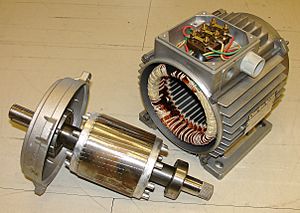Stator facts for kids
A stator is a very important part of many machines that spin, like electric motors and generators. Think of it as the "still" or "stationary" part of the machine. While other parts, like the rotor, spin around, the stator stays fixed in place. It helps create the power or movement that makes these machines work.
Contents
What is a Stator?
The word "stator" comes from the word "stationary," which means not moving. In an electric machine, the stator is the part that doesn't rotate. It's usually the outer casing or frame of the machine, and it holds important wires or magnets.
Stators in Electric Motors
In an electric motor, the stator helps turn electrical energy into movement. It often contains coils of wire that create a magnetic field when electricity flows through them. This magnetic field then pushes or pulls on the spinning part (the rotor), making it turn. This is how many things, from electric fans to electric cars, get their power to move!
Stators in Generators
Generators do the opposite of motors: they turn movement into electrical energy. In a generator, the stator also has coils of wire. As the rotor spins inside the stator, it creates a changing magnetic field. This changing magnetic field then makes electricity flow through the wires in the stator. This is how power plants create the electricity we use in our homes.
How a Stator Works
The stator and the rotor work together like a team. The stator provides a steady magnetic field, or it's where electricity is made when a moving magnetic field passes by. Depending on the machine, the stator can either be the part that creates the magnetic field (like a big magnet) or the part that gets affected by the magnetic field from the rotor. This interaction between the still stator and the spinning rotor is key to how electric machines operate.
Images for kids
-
Stator winding of a generator at a hydroelectric power station.
See also
 In Spanish: Estator para niños
In Spanish: Estator para niños






